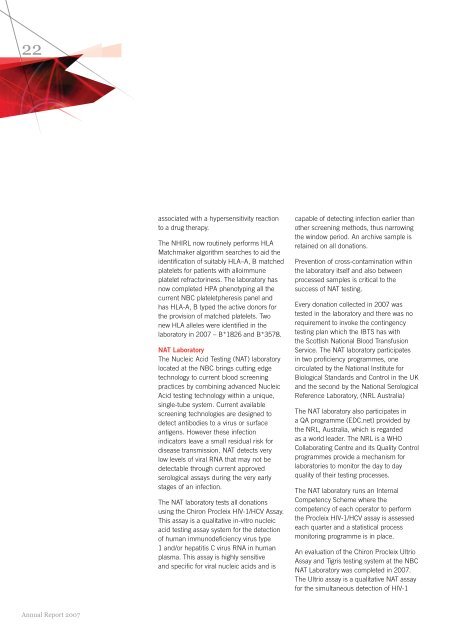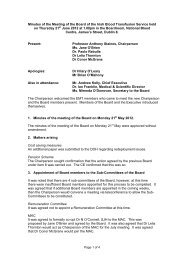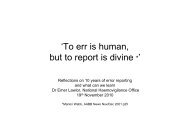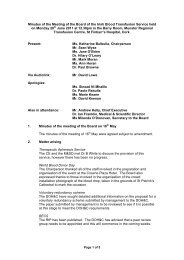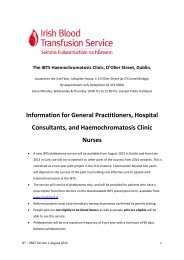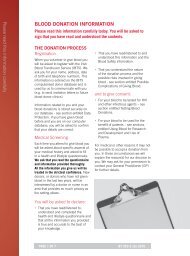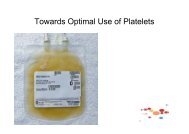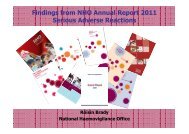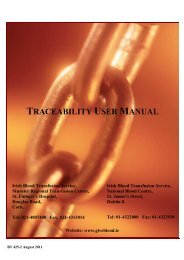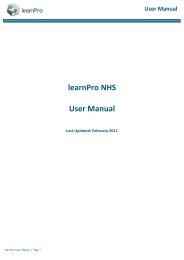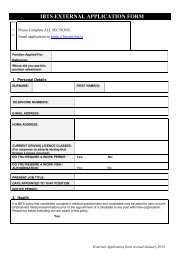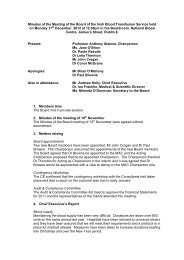IBTS Annual Report 2007.pdf - Irish Blood Transfusion Service
IBTS Annual Report 2007.pdf - Irish Blood Transfusion Service
IBTS Annual Report 2007.pdf - Irish Blood Transfusion Service
You also want an ePaper? Increase the reach of your titles
YUMPU automatically turns print PDFs into web optimized ePapers that Google loves.
22<br />
associated with a hypersensitivity reaction<br />
to a drug therapy.<br />
The NHIRL now routinely performs HLA<br />
Matchmaker algorithm searches to aid the<br />
identification of suitably HLA–A, B matched<br />
platelets for patients with alloimmune<br />
platelet refractoriness. The laboratory has<br />
now completed HPA phenotyping all the<br />
current NBC plateletpheresis panel and<br />
has HLA-A, B typed the active donors for<br />
the provision of matched platelets. Two<br />
new HLA alleles were identified in the<br />
laboratory in 2007 – B*1826 and B*3578.<br />
NAT Laboratory<br />
The Nucleic Acid Testing (NAT) laboratory<br />
located at the NBC brings cutting edge<br />
technology to current blood screening<br />
practices by combining advanced Nucleic<br />
Acid testing technology within a unique,<br />
single-tube system. Current available<br />
screening technologies are designed to<br />
detect antibodies to a virus or surface<br />
antigens. However these infection<br />
indicators leave a small residual risk for<br />
disease transmission. NAT detects very<br />
low levels of viral RNA that may not be<br />
detectable through current approved<br />
serological assays during the very early<br />
stages of an infection.<br />
The NAT laboratory tests all donations<br />
using the Chiron Procleix HIV-1/HCV Assay.<br />
This assay is a qualitative in-vitro nucleic<br />
acid testing assay system for the detection<br />
of human immunodeficiency virus type<br />
1 and/or hepatitis C virus RNA in human<br />
plasma. This assay is highly sensitive<br />
and specific for viral nucleic acids and is<br />
capable of detecting infection earlier than<br />
other screening methods, thus narrowing<br />
the window period. An archive sample is<br />
retained on all donations.<br />
Prevention of cross-contamination within<br />
the laboratory itself and also between<br />
processed samples is critical to the<br />
success of NAT testing.<br />
Every donation collected in 2007 was<br />
tested in the laboratory and there was no<br />
requirement to invoke the contingency<br />
testing plan which the <strong>IBTS</strong> has with<br />
the Scottish National <strong>Blood</strong> <strong>Transfusion</strong><br />
<strong>Service</strong>. The NAT laboratory participates<br />
in two proficiency programmes, one<br />
circulated by the National Institute for<br />
Biological Standards and Control in the UK<br />
and the second by the National Serological<br />
Reference Laboratory, (NRL Australia)<br />
The NAT laboratory also participates in<br />
a QA programme (EDC.net) provided by<br />
the NRL, Australia, which is regarded<br />
as a world leader. The NRL is a WHO<br />
Collaborating Centre and its Quality Control<br />
programmes provide a mechanism for<br />
laboratories to monitor the day to day<br />
quality of their testing processes.<br />
The NAT laboratory runs an Internal<br />
Competency Scheme where the<br />
competency of each operator to perform<br />
the Procleix HIV-1/HCV assay is assessed<br />
each quarter and a statistical process<br />
monitoring programme is in place.<br />
An evaluation of the Chiron Procleix Ultrio<br />
Assay and Tigris testing system at the NBC<br />
NAT Laboratory was completed in 2007.<br />
The Ultrio assay is a qualitative NAT assay<br />
for the simultaneous detection of HIV-1<br />
<strong>Annual</strong> <strong>Report</strong> 2007


